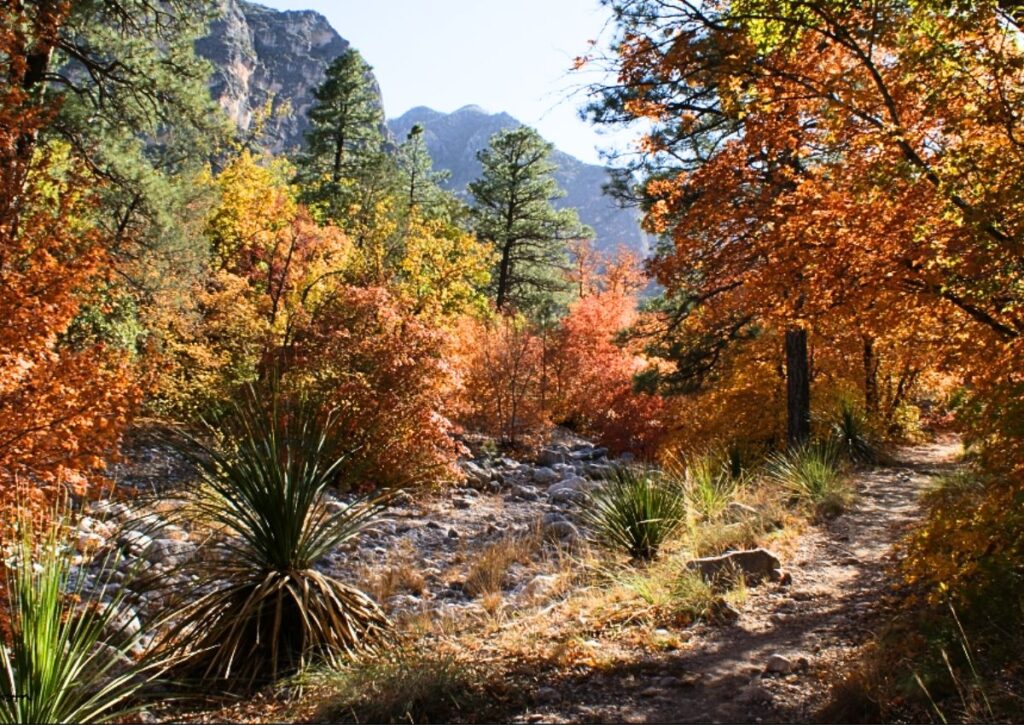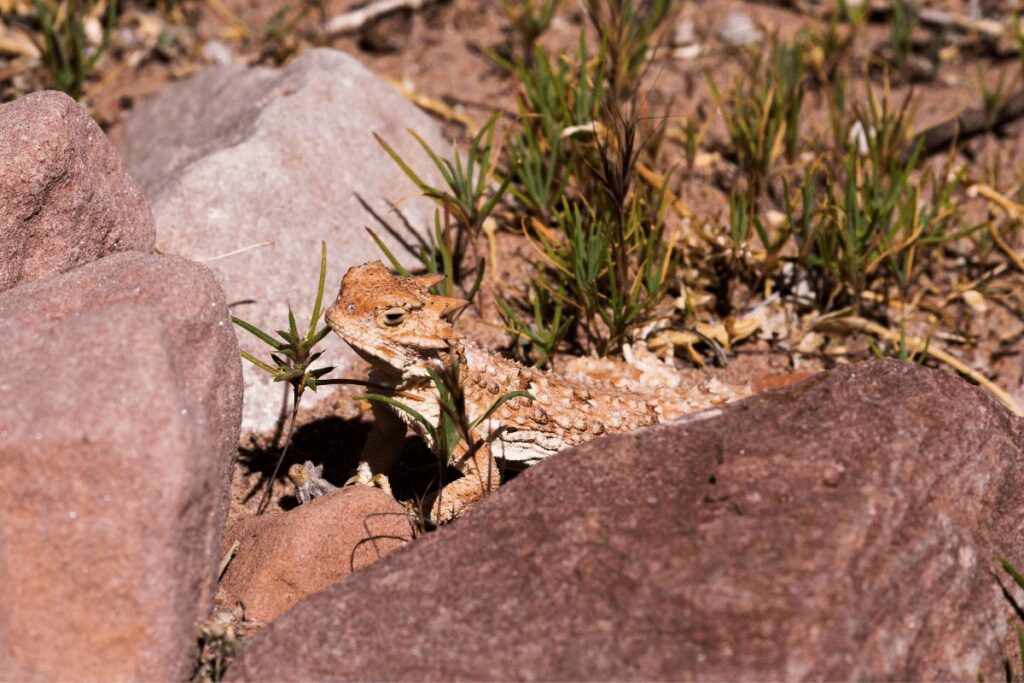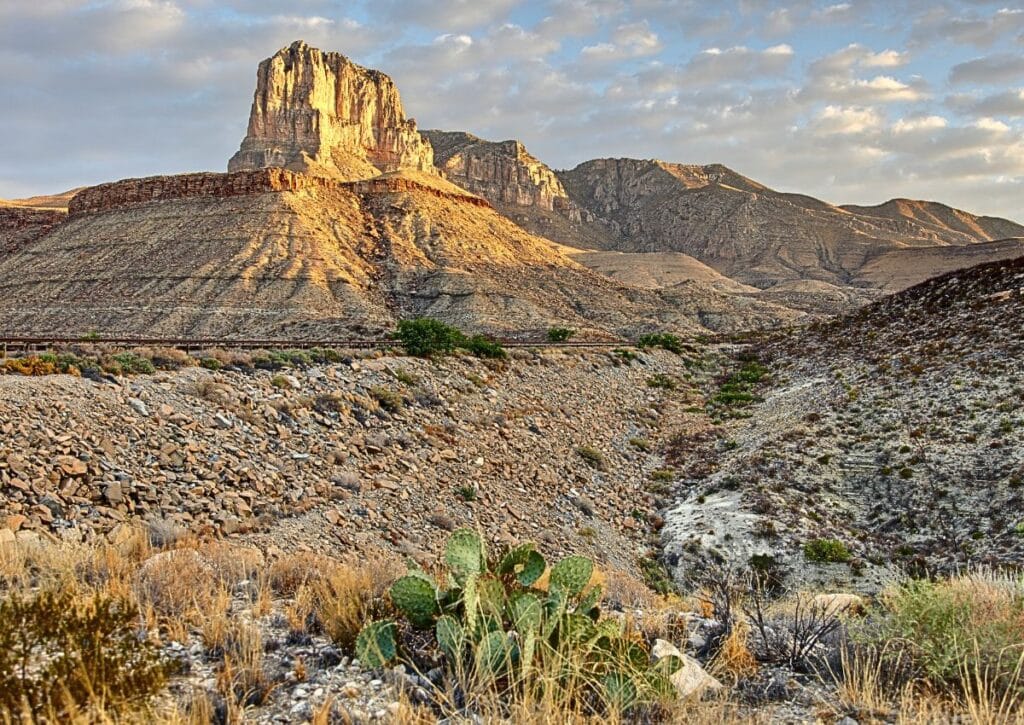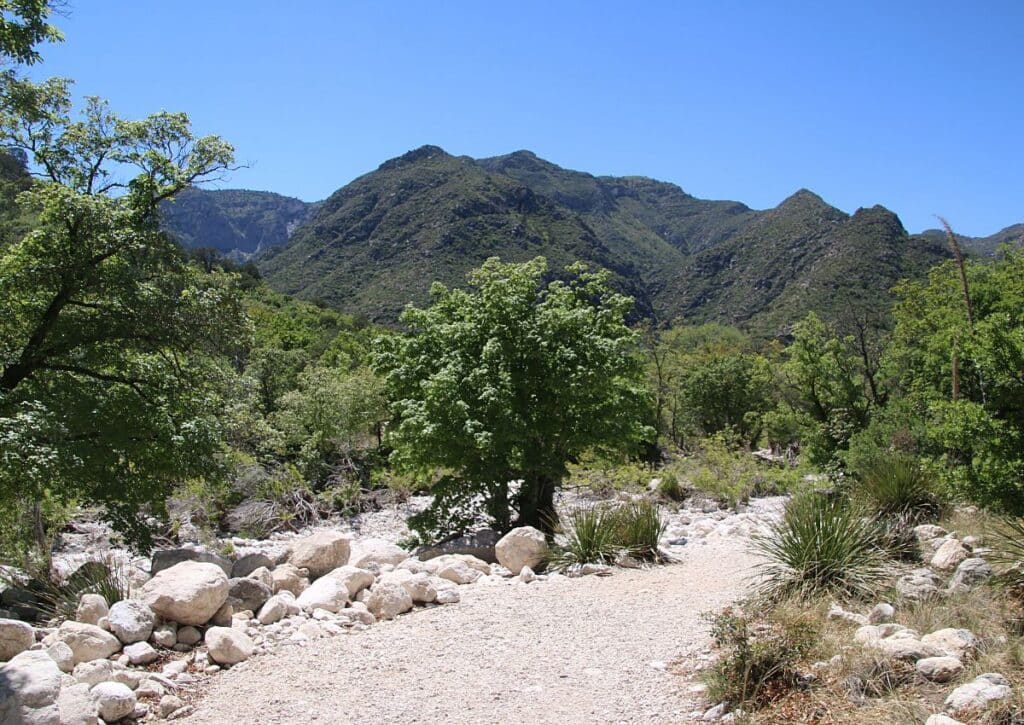Explore McKittrick Canyon in Guadalupe Mountains National Park: hikes, wildlife, camping tips, fishing, and safety, for an immersive nature experience.
Guadalupe Mountains National Park’s Mckittrick Canyon, is a true jewel in the heart of Texas. Here, we invite you to embark on an unforgettable adventure through scenic hiking trails, immerse yourself in the beauty of the desert ecosystems, and discover the rich biodiversity that thrives within this remarkable landscape.
Whether you are an avid hiker, a nature enthusiast, or simply seeking a tranquil camping getaway, this park has it all. Join us as we guide you through the wonders of Guadalupe Mountains National Park Mckittrick Canyon, a testament to the breathtaking natural beauty that Texas state parks have to offer.
Embark on a journey through the mesmerizing hiking trails that wind through Guadalupe Mountains National Park Mckittrick Canyon, providing stunning panoramic views of the surrounding landscapes. From beginner-friendly paths to challenging routes, there is something for every adventurer here.
Set up camp amidst the pristine wilderness and immerse yourself in the peacefulness of nature. Keep your eyes peeled for wildlife sightings as you traverse the trails, where encounters with diverse species of plants and animals are a common occurrence.
As your hiking guide, we will unveil the hidden treasures of Guadalupe Mountains National Park Mckittrick Canyon, ensuring you make the most of your visit to this natural wonder. From backcountry camping tips to the best spots for wildlife viewing, we have got you covered.
So, lace up your hiking boots, pack your camping gear, and get ready to explore the scenic beauty and biodiversity of Guadalupe Mountains National Park Mckittrick Canyon. Let us be your trusted companion as we embark on this unforgettable journey together.
Experience the Beauty of McKittrick Canyon
McKittrick Canyon is a stunning natural wonder located within Guadalupe Mountains National Park. What sets this canyon apart is its remarkable display of fall colors that paint the landscape with vibrant reds, yellows, and browns.
Against the backdrop of the arid Chihuahuan desert, the foliage creates a breathtaking contrast that captivates hikers and nature lovers alike.
Exploring McKittrick Canyon is an opportunity to immerse yourself in the unique beauty of this arid landscape. As you hike through the canyon, you’ll encounter other natural wonders, such as the remarkable Grotto. This cave-like formation is formed by the percolation of water through limestone, creating awe-inspiring stalactites and stalagmites.
Unforgettable Beauty in All Seasons
While McKittrick Canyon is particularly famous for its fall colors, its beauty extends beyond this season. Throughout the year, the canyon offers a wealth of natural wonders waiting to be explored.
From diverse plant life to stunning rock formations, each visit to McKittrick Canyon promises an unforgettable experience.
Whether you’re an avid hiker or simply someone who appreciates the beauty of nature, McKittrick Canyon is a destination that should not be missed.
The combination of its fall colors, the arid landscape of the Chihuahuan desert, and the abundance of natural wonders make it a truly breathtaking place to explore.
Hours and Services at McKittrick Canyon
McKittrick Canyon, located within Guadalupe Mountains National Park, operates as a day-use only area. Visitors can explore the canyon between the hours of 8:00 a.m. and 5:00 p.m. Mountain Time.
It is important to plan your visit accordingly and exit the canyon before closing time, as the entrance gate on U.S. Highway 62/180 is locked each evening.
To begin your exploration of McKittrick Canyon, we recommend visiting the visitor center located at the mouth of the canyon. Here, you can gather important information and resources for your hike, such as park brochures and maps. The visitor center also features exhibits that provide insights into the history and geology of the area.
Accessing McKittrick Canyon
Access to McKittrick Canyon is convenient and straightforward. You can enter the canyon by following the designated trail from the visitor center.
The trail is well-marked and offers a pleasant walk through the canyon, allowing you to immerse yourself in its natural beauty from the very beginning of your adventure.
As you plan your visit to McKittrick Canyon, remember to check the park’s official website for any updates or changes in operating hours. By being well-prepared and familiar with the park’s services and access, you can make the most of your time exploring this captivating destination.
McKittrick Canyon Hikes
Exploring the hiking trails in McKittrick Canyon is a must-do when visiting Guadalupe Mountains National Park. One of the most popular hikes is the trail to Pratt Cabin, which spans approximately 4.8 miles round trip.
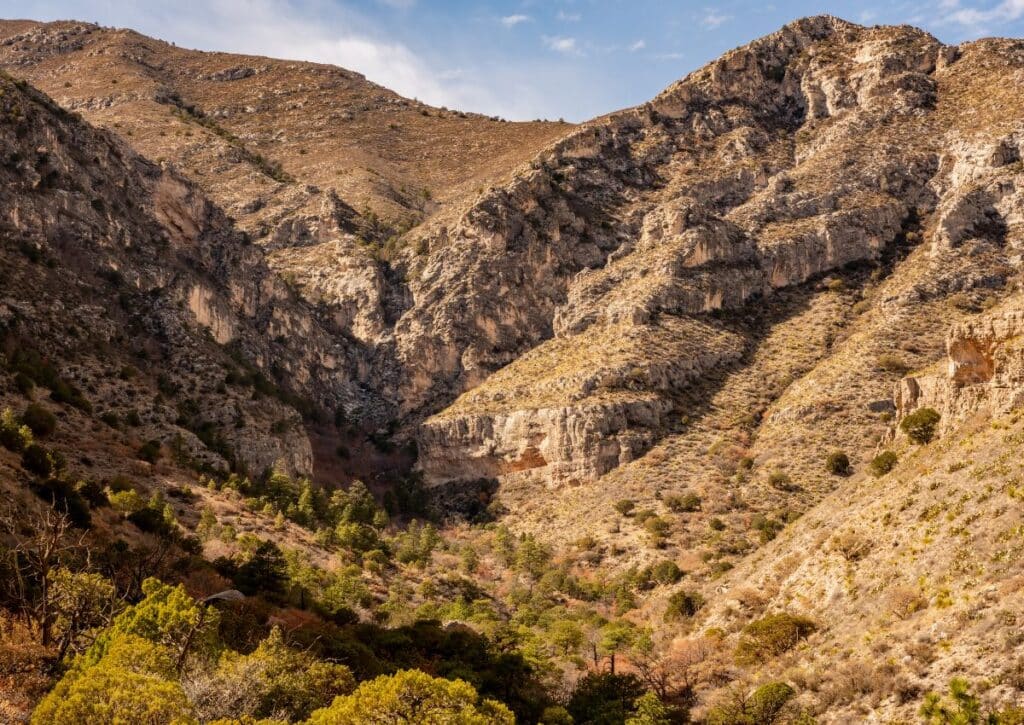
This scenic route takes you through desert, transition, and canyon woodlands, providing a diverse and captivating landscape throughout the journey.
Another highlight of McKittrick Canyon is the Grotto, a unique formation that resembles a cave. To reach the Grotto, hikers can follow a spur trail that also leads to the historic Hunter Line Cabin.
This trail not only offers a glimpse into the area’s history but also showcases the fascinating natural wonders created by water percolating through the limestone, resulting in stunning stalactites and stalagmites.
When planning your hike in McKittrick Canyon, it’s important to consider the length and difficulty of the trails. While the Pratt Cabin hike is moderately challenging, hikers with different skill levels can still enjoy the experience with proper preparation and caution.
Remember to bring along plenty of water, wear appropriate footwear, and be mindful of weather conditions to ensure a safe and enjoyable hike.
McKittrick Canyon Places
When visiting Guadalupe Mountains National Park McKittrick Canyon, there are several fascinating places within the canyon that are worth exploring.
One of these places is The Pinery, a historic site that was once part of the Buttermilk Overland Stagecoach Route in the 1800s. The Pinery offers a glimpse into the rich history of the area and provides a unique experience for visitors.
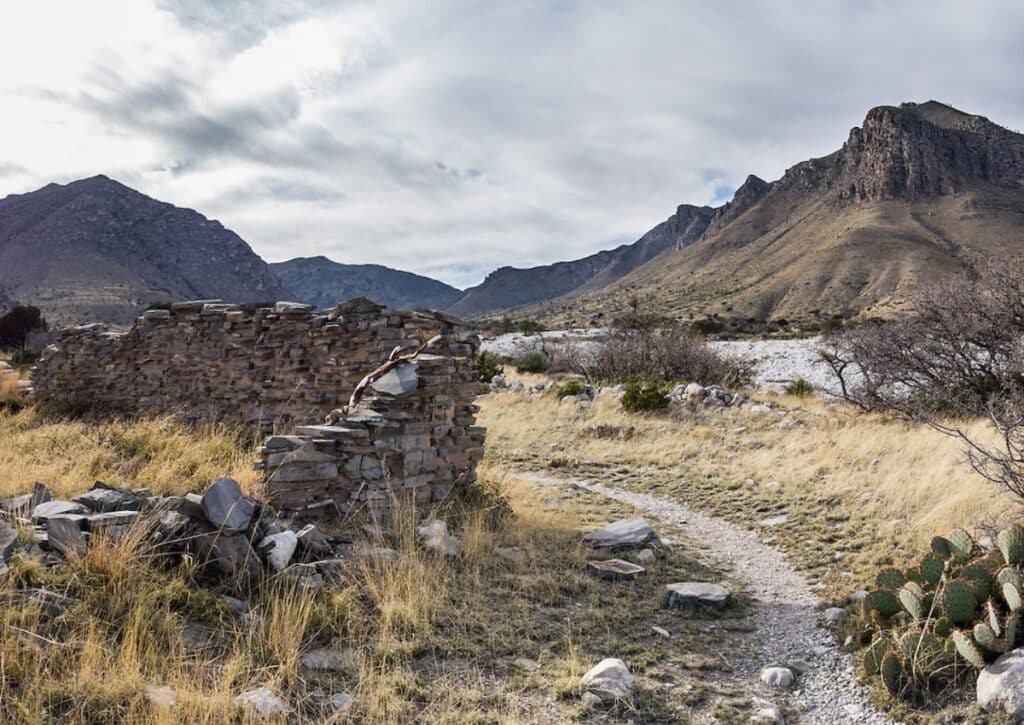
Another notable location within McKittrick Canyon is Frijole Ranch, which offers a fascinating insight into the diverse cultural and natural heritage of the canyon.
The ranch showcases the history of the people who lived and worked in the area, and visitors can explore the historic buildings and exhibits that tell the story of the canyon’s past.
McKittrick Canyon is renowned for its diverse range of plant and animal species, making it a paradise for nature enthusiasts. It is named after Felix McKittrick, a cattle rancher who settled near the canyon in the late 1800s. While exploring the canyon, visitors may have the opportunity to spot a variety of wildlife, such as rattlesnakes and deer, adding to the unique and exciting experience of being in McKittrick Canyon.
Wildlife in McKittrick Canyon, Guadalupe Mountains National Park: A Hiker’s Guide
Tucked within the Guadalupe Mountains of West Texas, McKittrick Canyon stands as a unique gem offering visitors a glimpse into the diverse range of ecosystems and the enchanting wildlife that call this area home. Whether you’re a seasoned hiker or a beginner, understanding the wildlife of this region will make your experience even richer. Here’s a guide to help you appreciate the creatures you might encounter on your journey.
Mammals
1. Mule Deer: These graceful animals, distinguished by their large ears, are commonly sighted in the canyon. They’re usually seen during the early morning and late afternoon when they come out to graze.
2. Elk: Although less common than mule deer, you might still spot an elk if you’re lucky. Keep an eye out for them in open areas.
3. Gray Fox: These small carnivores are nocturnal, but early morning hikers might catch a glimpse of one. They have a bushy tail with a black stripe and are known for their ability to climb trees.
4. Ringtail: Also known as the ringtail cat, this is a small mammal native to the American Southwest. They’re nocturnal and have a distinct, long, striped tail.
5. Rock Squirrels and Golden-mantled Ground Squirrels: These small rodents are quite common and can be seen darting around rocks and trees, often looking for food.
Birds
6. Acorn Woodpecker: Known for their unique habit of storing acorns in tree holes, these woodpeckers are easily recognizable by their black and white bodies and red-capped heads.
7. Mexican Jay: These large jays can be seen (and heard) throughout the canyon. They’re social birds, often seen in groups.
8. Peregrine Falcon: This majestic bird of prey nests on cliff sides. If you’re lucky, you might see one soaring overhead or perched on a high vantage point.
9. Mountain Bluebird: A beautiful sight, these birds have bright blue plumage and can be seen fluttering about in open spaces.
Reptiles and Amphibians
10. Western Diamondback Rattlesnake: Always be cautious and watch your step. While rattlesnakes prefer to avoid humans, they can be defensive when surprised. Listen for their rattling sound as a warning.
11. Mountain Short-horned Lizard: These small reptiles can be seen basking in the sun on rocks.
12. Red-spotted Toad: After rainstorms, you might find these amphibians in puddles and waterways.
Bears in McKittrick Canyon, Guadalupe Mountains National Park
While McKittrick Canyon in the Guadalupe Mountains National Park is more renowned for its stunning foliage, particularly in the fall, and its varied wildlife, the presence of bears, specifically the Black Bear, adds an exciting dimension to any hiking experience.
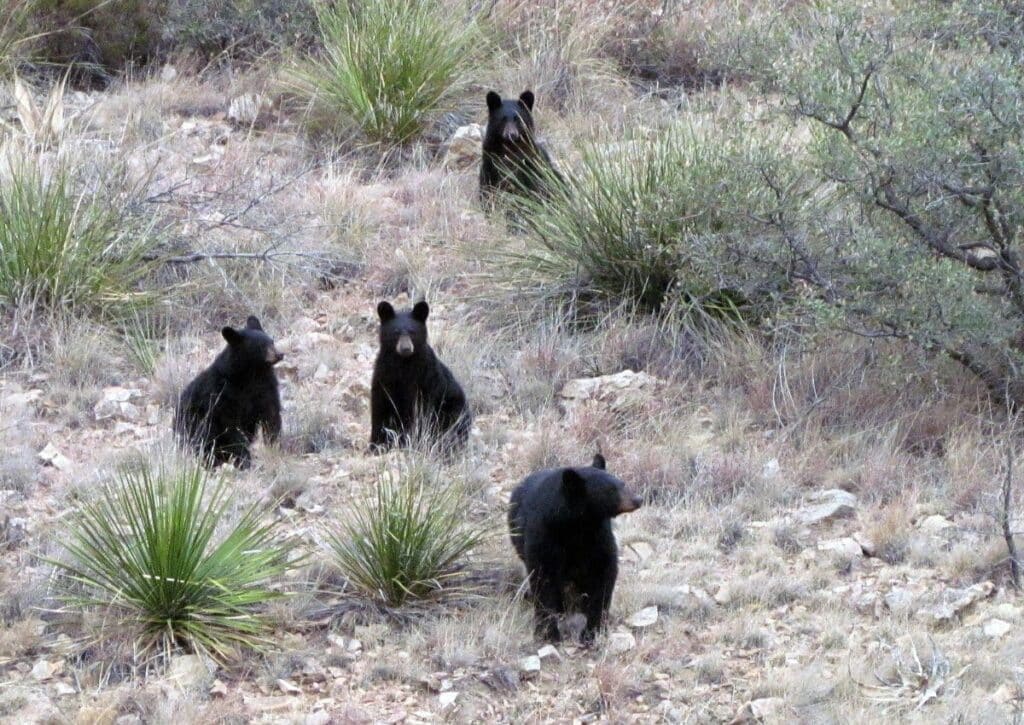
Here’s what you need to know:
1. Returning Natives: Historically, black bears roamed the Guadalupe Mountains, but hunting and habitat loss led to their disappearance from Texas. However, in recent decades, bears have been migrating back from neighboring New Mexico, re-establishing their presence.
2. Identification: Black bears can range in color from black to cinnamon. They have a straight profile on their face and short, non-retractable claws.
3. Behavior and Habitat: Black bears are generally shy and will avoid human contact. They prefer wooded areas and can often be spotted near water sources or berry patches. However, their natural curiosity and strong sense of smell can lead them to areas inhabited by humans, especially if food is available.
Safety Tips for Hikers:
1. Make Noise: If you’re hiking in bear territory, it’s a good idea to make noise periodically, especially around blind corners, to alert bears of your presence and avoid surprising them.
2. Store Food Properly: If you’re planning to camp or bring food, make sure it’s stored in bear-proof containers or hung from a tree away from your campsite. The smell of food can attract bears.
3. Hike in Groups: There’s safety in numbers. Bears are more likely to avoid groups of people.
4. Carry Bear Spray: While encounters are rare, it’s always a good idea to be prepared. Bear spray can deter a bear if it feels threatened.
5. Know What to Do in an Encounter: If you see a bear, speak calmly and firmly while slowly backing away. Avoid direct eye contact, which can be perceived as a threat. If the bear approaches, make yourself look bigger by raising your arms and stand your ground.
6. Do Not Run: Running might trigger a chase instinct. Instead, slowly move away without turning your back on the bear.
Remember, the key is prevention. Bears do not typically pose a threat to humans unless they feel threatened or provoked. Respecting their habitat and understanding their behaviors will not only ensure your safety but also provide you with a memorable experience in the magnificent McKittrick Canyon.
Tips for Wildlife Viewing:
- Keep a Safe Distance: Never approach or try to feed wild animals. Not only is it unsafe for you, but it can also be harmful to them.
- Quiet Observation: Move slowly and speak softly. Loud noises or sudden movements can scare animals away.
- Hike in the Morning or Late Afternoon: Many animals are crepuscular, meaning they’re most active during these times.
- Leave No Trace: Maintain the natural habitat by not leaving any trash behind and staying on marked trails.
Remember, while it’s exciting to spot wildlife, it’s essential to respect their space and natural behaviors. With a bit of patience and understanding, your hike through McKittrick Canyon will be filled with awe-inspiring moments as you witness the incredible biodiversity of Guadalupe Mountains National Park.
McKittrick Canyon Fishing Guide
McKittrick Canyon, with its breathtaking scenery and serenity, is primarily known for its hiking trails and natural beauty rather than its fishing opportunities. However, for those who are curious about casting a line in or around the area, this guide offers a deeper dive into what you might expect.
Fishing Locations Near McKittrick Canyon:
While McKittrick Canyon itself might not be a prime fishing destination, the surrounding Guadalupe Mountains and nearby areas provide some options:
1. Guadalupe River: Located further south of the National Park, the Guadalupe River is renowned for its rainbow trout, especially during the winter months.
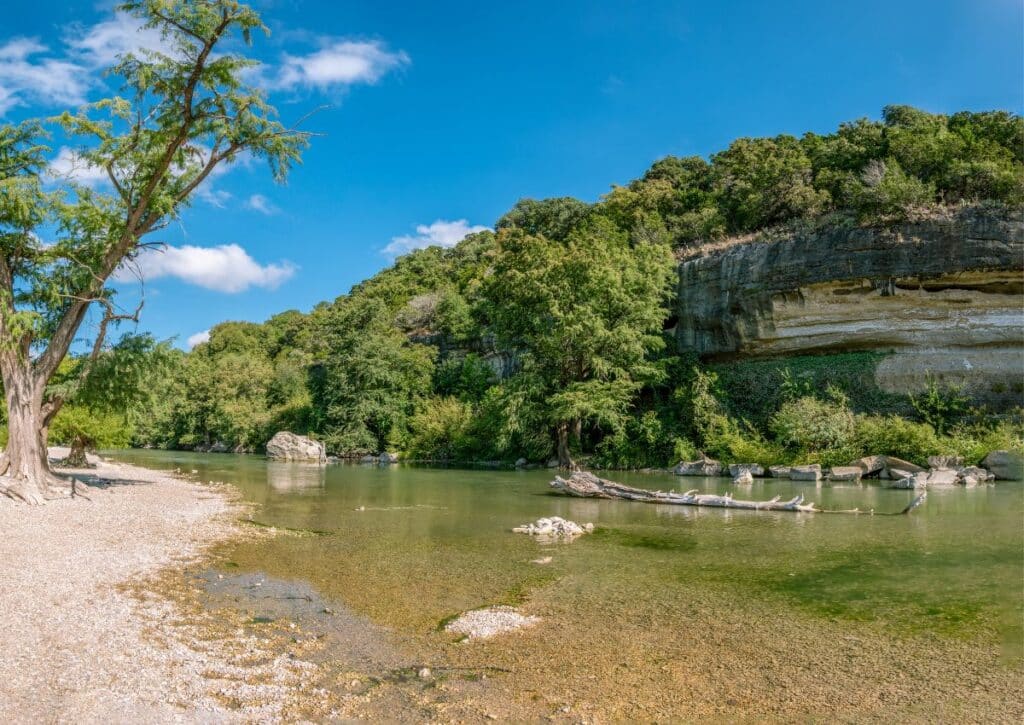
2. Local Stocked Ponds: Some nearby ranches or communities may have stocked ponds or small lakes where fishing is allowed, often for a fee or with permission.
What to Fish For:
1. Rainbow Trout: The Guadalupe River, in particular, is stocked with rainbow trout, making it a sought-after location for anglers in the winter.
2. Native Species: In smaller streams or ponds around the area, you might find native species like bluegill, catfish, or bass.
Fishing Tips:
1. Check Local Regulations: Always ensure you’re aware of the local fishing regulations. This includes size and bag limits, permitted baits, and specific fishing seasons.
2. Go Early or Late: Fish are often most active during the cooler parts of the day, such as early morning or late afternoon.
3. Use Light Tackle: In clearer water, fish can be wary. Using lighter line and smaller hooks can increase your chances of success.
4. Be Stealthy: Especially in clearer and shallower waters, move slowly and quietly to avoid spooking the fish.
Gear Recommendations:
1. Lightweight Rod and Reel: A 5 to 6-foot rod with a light or ultralight spinning reel is versatile for most fish you’ll encounter.
2. Baits and Lures: Depending on the targeted species, consider live bait like worms or small artificial lures mimicking local prey.
3. Polarized Sunglasses: These help reduce glare, allowing you to spot fish in the water more easily.
4. Wading Shoes: If you plan to wade in the river or streams, a good pair of wading shoes will protect your feet and provide better grip.
Conservation:
Always practice catch and release, especially in areas with delicate ecosystems. Ensure you handle fish with care, wetting your hands before touching them to protect their slime coat. Release them as quickly as possible to minimize stress.
While McKittrick Canyon itself may not be a hotspot for fishing, the surrounding areas offer opportunities for those willing to explore. Always prioritize conservation and respect local regulations to ensure sustainable fishing for future generations.
McKittrick Canyon Camping Guide
McKittrick Canyon, located within the Guadalupe Mountains National Park, is renowned for its astonishing beauty, particularly in the fall when the leaves turn into a vibrant display of colors.
If you’re considering camping near this magnificent canyon, here’s everything you need to know.
Camping in Guadalupe Mountains National Park:
McKittrick Canyon does not have campgrounds directly within its boundaries due to its protected status and the park’s aim to preserve its unique environment. However, Guadalupe Mountains National Park offers campgrounds and backcountry camping options:
1. Pine Springs Campground:
- Location: Situated near the Pine Springs Visitor Center, this campground serves as the primary base for many visitors to the park.
- Facilities: It provides tent and RV camping (though no hookups are available). Flush toilets, potable water, and grills are available.
- Reservations: This is a first-come, first-served campground, so it’s essential to arrive early during peak seasons.
2. Dog Canyon Campground:
- Location: Located on the north side of the park, this more remote and less frequented campground provides a serene environment.
- Facilities: Tent and RV camping are available, with potable water, grills, and restrooms.
- Reservations: Like Pine Springs, Dog Canyon operates on a first-come, first-served basis.
3. Backcountry Camping:
- Permits: If you wish to camp in the park’s backcountry areas, you need a permit. These are available at the Pine Springs and Dog Canyon visitor centers.
- Locations: There are several designated backcountry campgrounds scattered throughout the park. Be sure to study a park map to understand the location and difficulty of access.
- Preparation: Remember, backcountry camping requires self-sufficiency. Ensure you have enough water, food, and suitable equipment.
Tips for Camping:
1. Respect the Environment: The park is a protected area with fragile ecosystems. Always practice Leave No Trace principles.
2. Water: While some campgrounds offer potable water, if you’re heading to the backcountry, ensure you carry enough. Water sources in the park can be scarce and unreliable.
3. Wildlife: The park is home to various wildlife, from mule deer to black bears. Always store food and scented items securely to avoid attracting them.
4. Weather: The Guadalupe Mountains can experience sudden weather changes. Be prepared for varying conditions, especially if you’re camping at higher elevations.
5. Check Park Alerts: Before your visit, check the official Guadalupe Mountains National Park website or contact the visitor centers for any alerts, closures, or updates.
While you cannot camp directly within McKittrick Canyon, the surrounding Guadalupe Mountains National Park offers plenty of opportunities for a memorable camping experience. Whether you’re at a designated campground or deep in the backcountry, the natural beauty and serenity of the region promise a unique and unforgettable adventure.
Planning Your Visit to McKittrick Canyon
When planning a visit to Guadalupe Mountains National Park McKittrick Canyon, it’s important to consider a few logistical details to ensure a smooth and enjoyable experience.
Firstly, there is a $10 per person fee to enter the national park, which can be paid at the McKittrick Canyon Visitors Center or at the trailhead.
Keep in mind that the park is open daily, but the entrance gate to McKittrick Canyon closes at specific times, so it’s essential to plan your visit accordingly.
Adequate parking is available at the visitors center, so you can easily park your vehicle and begin your exploration. Additionally, the visitors center provides essential facilities such as restrooms and a water spigot for your convenience. If you are planning to camp, there are designated campgrounds within Guadalupe Mountains National Park.
However, it’s advisable to have backup lodging options, especially during peak seasons. If you prefer a more adventurous experience, backcountry camping is also possible with a permit.
If you are looking for alternative lodging options, nearby towns such as White’s City and Carlsbad in New Mexico offer a range of accommodations.
These towns provide a comfortable base for those exploring McKittrick Canyon and allow you to immerse yourself in the natural beauty of the area. By planning your visit in advance and considering these details, you can make the most of your time in this breathtaking destination.
Conclusion
Guadalupe Mountains National Park McKittrick Canyon is a haven for outdoor enthusiasts seeking natural beauty and thrilling adventures. With its breathtaking views, diverse wildlife, and extensive hiking trails, this Texas treasure provides an unforgettable experience.
Immerse yourself in the awe-inspiring landscapes of McKittrick Canyon, where the vibrant fall colors contrast against the arid desert backdrop. Whether you’re an avid hiker or simply appreciate the wonders of nature, the trails within the canyon will leave you in awe.
Camping options in designated areas allow you to extend your stay and fully immerse yourself in the beauty of the park. Explore the diverse plant and animal species that call McKittrick Canyon home, from rattlesnakes to deer, and witness the unique sights and sounds of this remarkable destination.
Plan your visit to Guadalupe Mountains National Park McKittrick Canyon and embark on an adventure that combines natural beauty, outdoor activities, and unforgettable experiences. Discover the wonders of this hidden gem of Texas, where every step offers a new breathtaking view and a deeper appreciation for the world around us.
FAQ
What is Guadalupe Mountains National Park Mckittrick Canyon known for?
Guadalupe Mountains National Park Mckittrick Canyon is known for its scenic beauty and biodiversity. It is often referred to as the “most beautiful spot in Texas.”
Are there hiking trails in McKittrick Canyon?
Yes, McKittrick Canyon offers a variety of hiking trails that showcase the surrounding desert landscapes and offer breathtaking views.
Can I camp in Guadalupe Mountains National Park Mckittrick Canyon?
Yes, visitors have the opportunity to camp in designated campgrounds within Guadalupe Mountains National Park. Backcountry camping is also an option with a permit.
What wildlife can I expect to see in McKittrick Canyon?
While exploring McKittrick Canyon, visitors may encounter wildlife such as rattlesnakes and deer.
Are there any historical sites in McKittrick Canyon?
Yes, The Pinery and Frijole Ranch are two notable historical sites within McKittrick Canyon that offer a glimpse into the area’s history.
Are there any entrance fees for Guadalupe Mountains National Park McKittrick Canyon?
Yes, there is a $10 per person fee to enter Guadalupe Mountains National Park, which can be paid at the McKittrick Canyon Visitors Center or at the trailhead.
What are the visiting hours for McKittrick Canyon?
McKittrick Canyon operates as a day-use only area within Guadalupe Mountains National Park and can be accessed between the hours of 8:00 a.m. and 5:00 p.m. Mountain Time.

